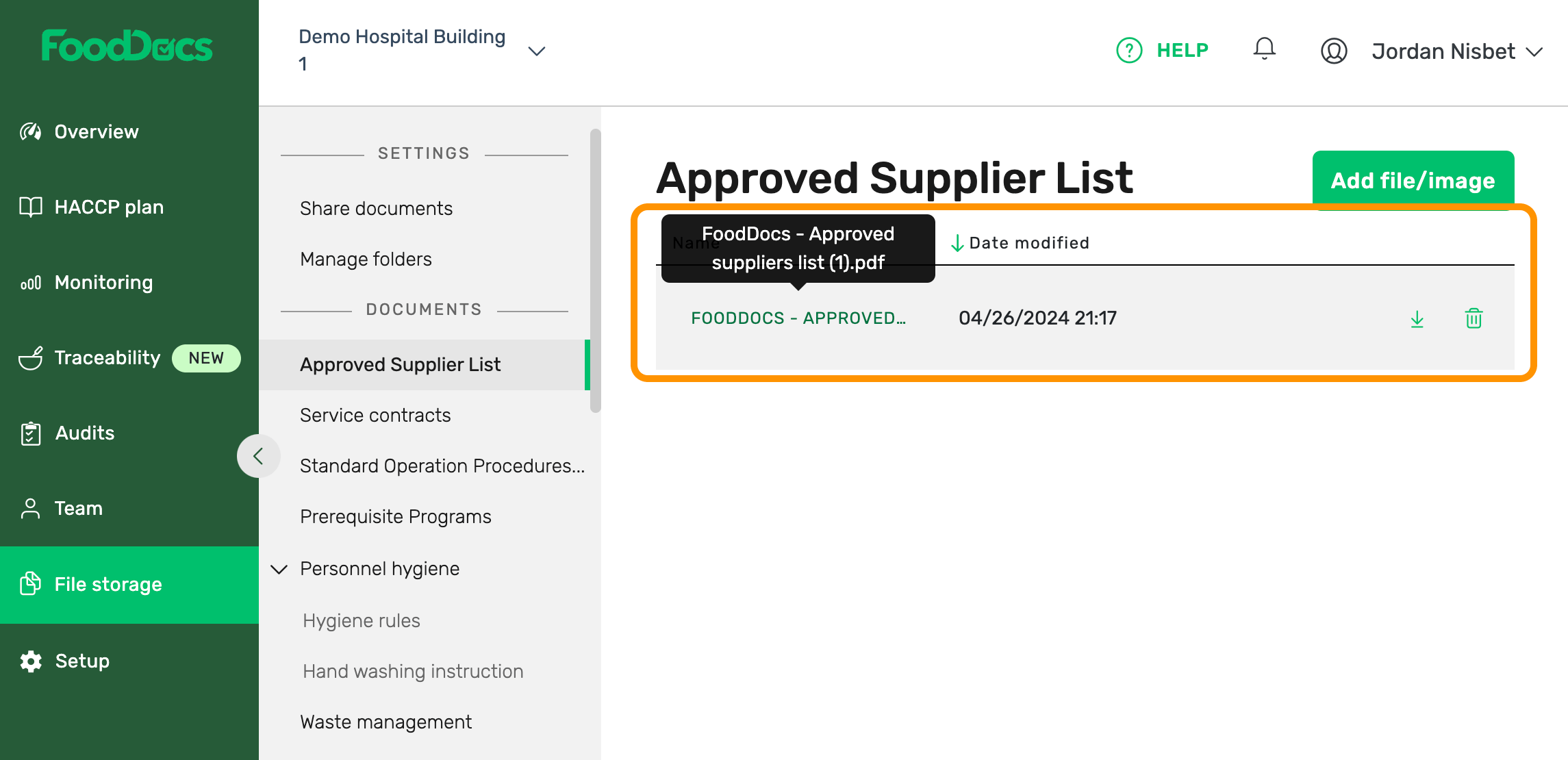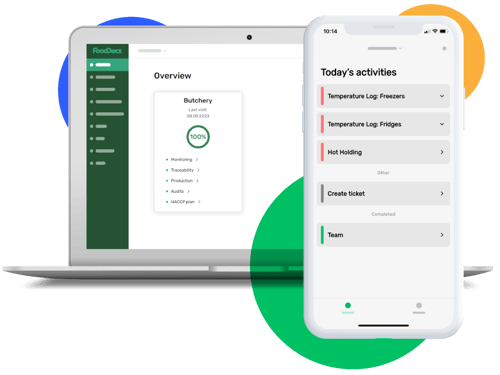APPROVED SUPPLIER LIST TEMPLATE (FREE DOWNLOAD)
| Supplier Name | Category | Contact Info | Supplier or Contract Number | Supplier Class (I-II-III) | Item ID Number | Item Description | Supplier Certification ID and Certification Body | Certification Effective Until (date) | Last Audit Date | Notes | |
|---|---|---|---|---|---|---|---|---|---|---|---|
Sidescroll to see additional columns and delete rows on smaller screen sizes
In the food industry, a company’s success relies not only on its own performance but also on the efficacy of each link in its supply chain. Maintaining high standards across suppliers is vital for ensuring quality and meeting regulatory requirements. One example of this is the FSMA mandates for Foreign Supplier Verification Programs.
But first...
What is an Approved Supplier List (ASL)?
The definition of an approved supplier list (aka approved vendor list) in the food industry is a comprehensive register of suppliers that a company has vetted and authorized for the procurement of ingredients, products, equipment, etc. Typically assembled by purchasing departments, the ASL is developed based on several factors including the suitability of the supplier's products for the company's needs, the financial stability of the supplier, and their track record of reliability and performance. Companies that end up on approved supplier lists meet specific criteria for food safety and quality (e.g., third-party audits reports, food safety compliance documents, and standards-based certifications).
5 Beneficial reasons why you need an ASL
You should treat an Approved Supplier List as a living document. They're necessary for food businesses of all sizes because they help give teams control of internal processes, procurement visibility, and risk management.
Creating one helps you simplify the procurement process, purchasing, ensures quality, compliments recall programs, allows you to more easily monitor performance over time, and can even keep money in your pocket. Here's how:
- Efficiency Boost: Quick reference saves time since you're only working with pre-approved vendors.
- Consistency: Helps you manage relationships and records, ensuring your preferred vendor list always has up-to-date info.
- Risk Management: Reduces the risk of supplier disruptions and other hiccups by only using reputable and high-quality vendors who have a commitment to quality.
- Top-Notch Quality: Vendors on your list are there because they meet your quality standards.
- Cost Savings: Better terms with regular suppliers mean potential budget benefits.
4 Helpful considerations when setting up your approved supplier list
You and your team can go about creating an ASL a number of ways. But these four tips will help give you a head start.
- Start with who you know: List out all current qualified vendors and suppliers. This initial list is your baseline. It's okay if it's short to begin with. Setting up a repeatable approval process for adding suppliers to your list is the key here.
- Set your standards: Determine your requirements for quality and decide what makes a vendor list-worthy. Think of their reputation, key documents like certificate of compliance, audits with legal and food industry standards, and proof of insurance. These criteria are crucial because they help make sure you partner with the best and keep your operations smooth and safe, with a few hiccups as possible.
- Check the facts: Use your quality requirements to evaluate both new and existing lists of suppliers. Make sure the information you have is correct and up-to-date, from suppliers' contact information to their last food safety audit date. Reach out if you need new or more details.
- Keep it fresh: Regularly review your supplier relationships. Depending on your contractual agreement this could be, for example, one or twice a year. Use quality management tools like vendor scorecards to monitor performance and adjust the list as market conditions change or better vendors come along.
What you need to create your Approved Supplier List (the bare minimum)
When you think of an ASL, it's more than just a random collection of companies you might buy from. While suppliers may not work for you, as part of the food supply chain, they work with you. Because of this, it's helpful to think of the companies on your approved supplier list as an extension of your team that meet your exact needs in food safety and quality.
Here's what you should include in your ASL to keep it as helpful and up-to-date as possible:
- Product ID number and commercial item description: The identifying item number and what it is.
- Supplier's Full Name: The official name of the company.
- Contact Info: Who to call or email, and where they’re located.
- Billing Details: They're preferred payment methods and terms.
- Service Category: What they supply, so you can find what you need fast.
- Approval Date: When they made the list, plus any expiry or renewal dates for keeping things current.
- Contractual Info: All the nitty-gritty terms you’ve agreed on.
- Compliance Docs: Necessary food safety certifications and licenses proving they stick to regulations.
The approved supplier list template you can download on this page is editable, so if you need more or less rows or different column titles, you can adjust the content to fit your specific needs.
We hope you find value in our Approved Supplier List template
Yes, having an ASL makes your life easier — but it's a two-way street. The suppliers on your approved list also desire that the food your producing or serving is being done so to high food safety and quality standards.
Keeping an updated Approved Suppliers List will help keep both you and the companies you partner with accountable. In the long run, this will keep relationships with vendors strong and fruitful which is a win-win for everyone involved.
Fill out and download our approved supplier list template today! Its columns include:
- Supplier Name
- Category
- Contact Info
- Supplier or Contract Number
- Supplier Class (I-II-III)
- Item ID Number
- Item Description
- Supplier Certification ID and Certification Body
- Certification Effective Until (date)
- Last Audit Date
- Notes
With FoodDocs, once downloaded, you can use one of our default folders or create an Approved Supplier List folder, and upload the file there for your team.

Frequent asked questions about ASLs
How do you tell if a supplier is an approved supplier (i.e., legitimate)?
If you're wondering how to tell if a supplier is legitimate, start by looking for official certifications by recognized certification bodies. In the food industry, for example, a certification could be HACCP, ISO 22000, FSSC 22000, and GMP. You should also make sure the supplier's contact information is legitimate. This includes their company address, phone number, and even business reputation (e.g., online reviews, presence on business directories).
Who maintains the approved supplier list?
In most businesses, the food industry included, the Purchasing Department team is responsible for maintaining and updating the Approved Supplier List.
What's the difference between an approved supplier and an approved vendor?
The difference between a supplier and a vendor depends on your definition. Many people use the term "approved supplier list" and "approved vendor list" interchangeably. However, their definitions are nuanced.
In the food industry, an approved supplier is a vetted and key partner that offers your food businesses specialized goods, services, or raw materials to produce food. Vendors, on the other hand, are considered to be a type of supplier. But the main difference is that approved vendors typically sell finished products or services to consumers or businesses.













